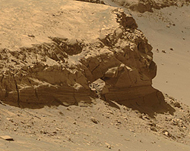Nasa’s eye in the Martian sky
Nasa’s new orbiter has captured spectacular images of a Mars rover next to a giant crater.

The Opportunity rover reached the edge of the Victoria Crater, which is more than 1,200km across, last week after a marathon trek.
The six-wheel robot has spent the past few days at the crater taking pictures of the jagged crevasse with its cliffs of thickly layered rocks, which hold clues about the Martian past.
Now, images of the rover and crater taken by the Mars Reconnaissance Orbiter, which went into orbit last year, have provided scientists with a bird’s-eye view of the crater and evidence of erosion around the rim.
In one image, the rover appears as a speck with its wheel tracks visible in the soil.
Hospitable to life?
By studying close-ups of the rover’s surroundings and aerial shots taken by the orbiter, scientists hope to discover the safest route for the rover to enter and probe the inner walls before it loses power.
 |
|
A close-up of the rover at the |
Steve Squyres of Cornell University, the rover’s principal investigator, said: “This vehicle could die at any minute. We have no guarantee that it’s going to last.”
Opportunity drove for 21 months to reach Victoria, which is five times bigger than another crater the rover spent six months studying in 2004.
Victoria‘s exposed rock layers promise to shed light on whether the place might once have been hospitable to life.
A preliminary analysis showed distinct patterns in the sedimentary rock layers, suggesting that the area experienced fluctuating climate, scientists have said.
 |
|
Opportunity must find a safe |
Opportunity and its twin, Spirit, have uncovered evidence of past water activity on the planet since their landings in 2004.
The Reconnaissance orbiter, the most powerful spacecraft to circle Mars, will formally begin its science mission next month.
Both missions are managed by Nasa’s Jet Propulsion Laboratory in Pasadena, California.
(Pictures courtesy of Nasa/JPL and the University of Arizona)